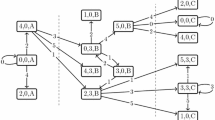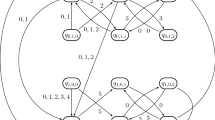Abstract
We prove that all algebraic bases β allow an eventually periodic representation of the elements of ℚ(β) with a finite alphabet of digits \({\cal A}\). Moreover, the classification of bases allowing that those representations have the socalled weak greedy property is given.
The decision problem whether a given pair (β, \({\cal A}\)) allows eventually periodic representations proves to be rather hard, for it is equivalent to a topological property of the attractor of an iterated function system.
Similar content being viewed by others
References
S. Akiyama, T. Borbély, H. Brunotte, A. Pethő and J. M. Thuswaldner, Generalized radix representations and dynamical systems. I, Acta Mathematica Hungarica 108 (2005), 207–238.
S. Akiyama, J. M. Thuswaldner and T. Zaïmi, Characterisation of the numbers which satisfy the height reducing property, Koninklijke Nederlandse Akademie van Wetenschappen. Indagationes Mathematicae 26 (2015), 24–27.
S. Baker, Z. Masáková, E. Pelantová and T. Vávra, On periodic representations in non-Pisot bases, Monatshefte für Mathematik 184 (2017), 1–19.
D. W. Boyd, Salem numbers of degree four have periodic expansions, in Théorie des nombres (Quebec, PQ, 1987), de Gruyter, Berlin, 1989, pp. 57–64.
D. W. Boyd, On the beta expansion for Salem numbers of degree 6, Mathematics of Computation 65 (1996), 861–875.
M. Brzicová, C. Frougny, E. Pelantová and M. Svobodová, On-line multiplication and division in real and complex bases, in 2016 IEEE 23rd Symposium on Computer Arithmetic (ARITH), IEEE, Los Alamitos, CA, 2015, pp. 134–141.
Y. Bugeaud, On a property of Pisot numbers and related questions, Acta Mathematica Hungarica 73 (1996), 33–39.
P. Erdös, I. Joó and V. Komornik, Characterization of the unique expansions \(1 = \sum\nolimits_{i = 1}^\infty {{q^{-{n_i}}}} \) and related problems, Bulletin de la Société Mathématique de France 118 (1990), 377–390.
D.-J. Feng, On the topology of polynomials with bounded integer coefficients, Journal of the European Mathematical Society 18 (2016), 181–193.
K. G. Hare, The structure of the spectra of Pisot numbers, Journal of Number Theory 105 (2004), 262–274.
K. G. Hare, Z. Masáková and T. Vávra, On the spectra of Pisot-cyclotomic numbers, Letters in Mathematical Physics 108 (2018), 1729–1756.
T. Hejda and E. Pelantová, Spectral properties of cubic complex Pisot units, Mathematics of Computation 85 (2016), 401–421.
J. E. Hutchinson, Fractals and self-similarity, Indiana University Mathematics Journal 30 (1981), 713–747.
V. Kala and T. Vávra, Periodic representations in algebraic bases, Monatshefte für Mathematik 188 (2019), 109–119.
Z. Masáková, K. Pastirčáková and E. Pelantová, Description of spectra of quadratic Pisot units, Journal of Number Theory 150 (2015), 168–190.
M. Minervino and J. Thuswaldner, The geometry of non-unit Pisot substitutions, Université de Grenoble. Annales de l’Institut Fourier 64 (2014), 1373–1417.
J. Neukirch, Algebraic Number Theory, Grundlehren der Mathematischen Wissenschaften, Vol. 322, Springer, Berlin, 1999.
A. Rényi, Representations for real numbers and their ergodic properties, Acta Mathematica. Academiae Scientiarum Hungaricae 8 (1957), 477–493.
K. Schmidt, On periodic expansions of Pisot numbers and Salem numbers, Bulletin of the London Mathematical Society 12 (1980), 269–278.
J. Šíma and P. Savický, Quasi-periodic β-expansions and cut languages, Theoretical Computer Science 720 (2018), 1–23.
W. Steiner and J. M. Thuswaldner, Rational self-affine tiles, Transactions of the American Mathematical Society 367 (2015), 7863–7894.
W. P. Thurston, Groups, tilings and finite state automata Research report, Geometry Computing Group, AMS colloquium lectures, Minneapolis, MN, 1989.
T. Zaïmi, On an approximation property of Pisot numbers. II, Journal de Théorie des Nombres de Bordeaux 16 (2004), 239–249.
Acknowledgements
The author thanks the anonymous reviewer for many useful comments.
This work has been supported by Czech Science Foundation GAČR, grant 17-04703Y, and by Charles University Research Centre program No. UNCE/SCI/022.
Author information
Authors and Affiliations
Corresponding author
Rights and permissions
About this article
Cite this article
Vávra, T. Periodic representations in Salem bases. Isr. J. Math. 242, 83–95 (2021). https://doi.org/10.1007/s11856-021-2123-3
Received:
Revised:
Published:
Issue Date:
DOI: https://doi.org/10.1007/s11856-021-2123-3




